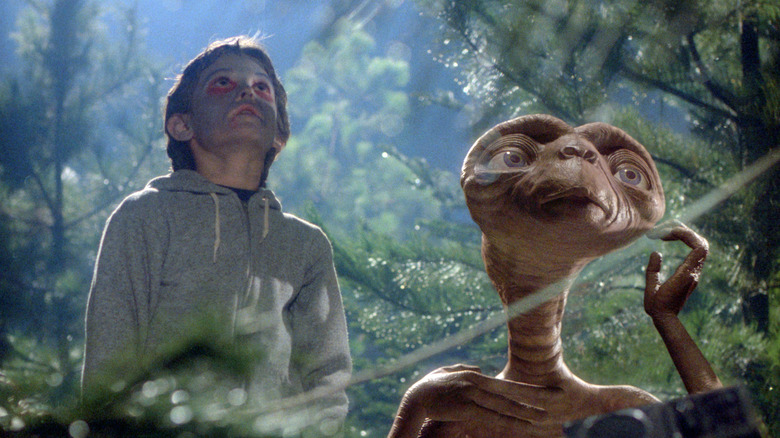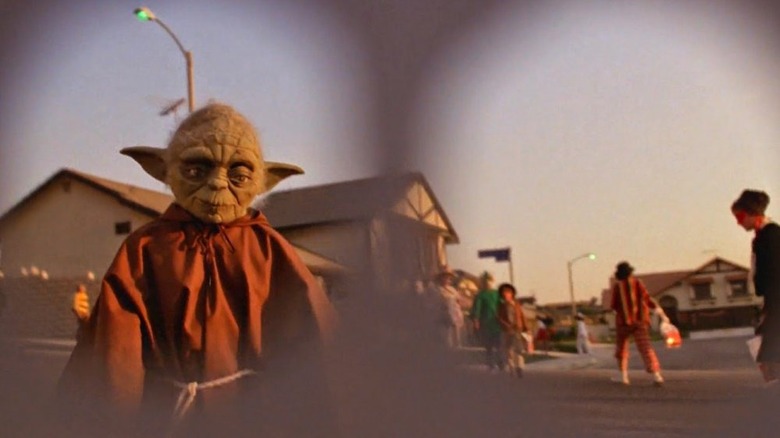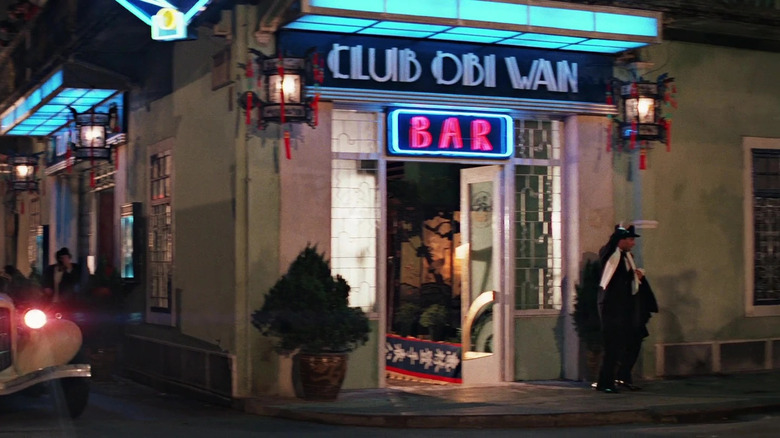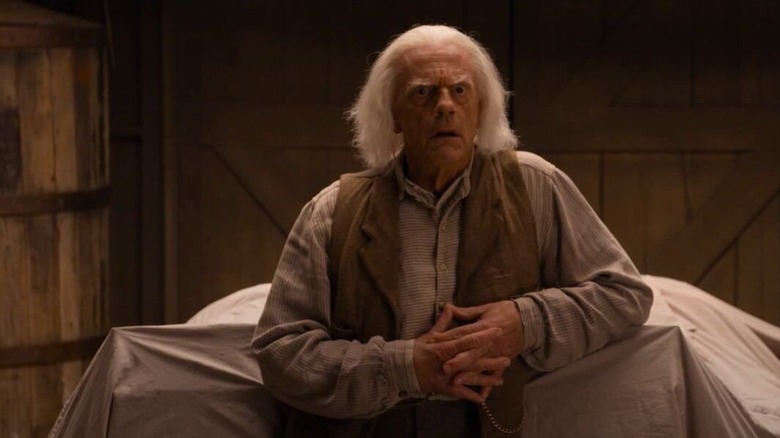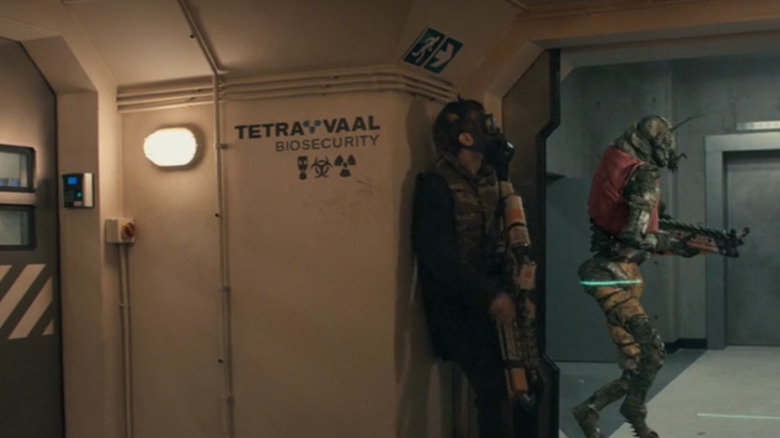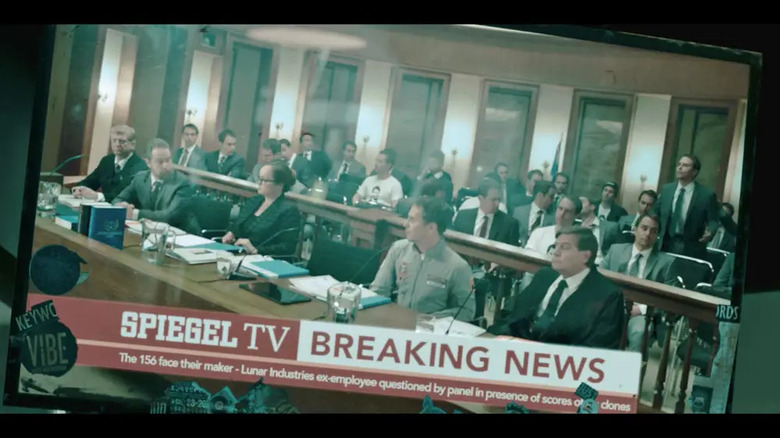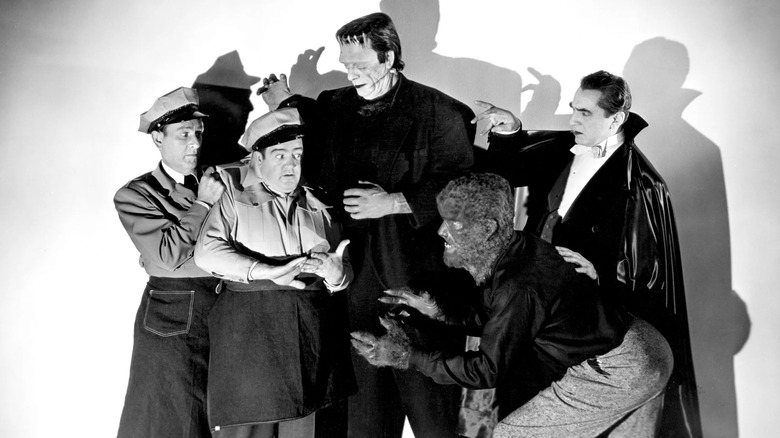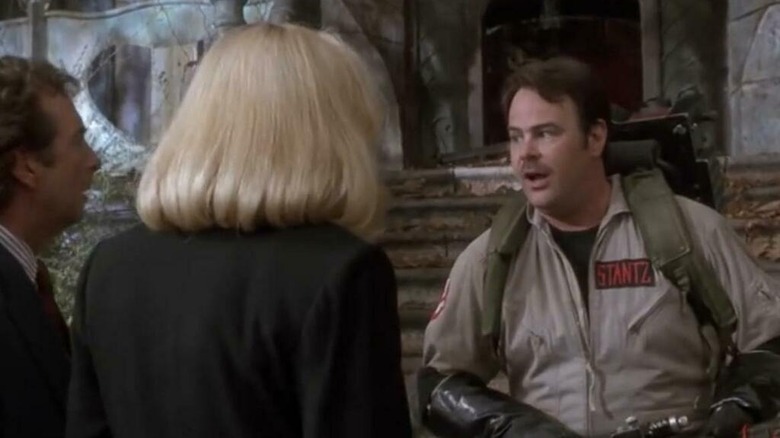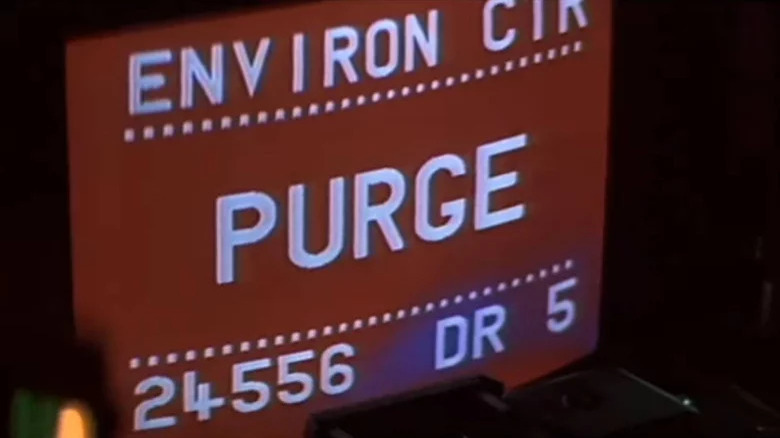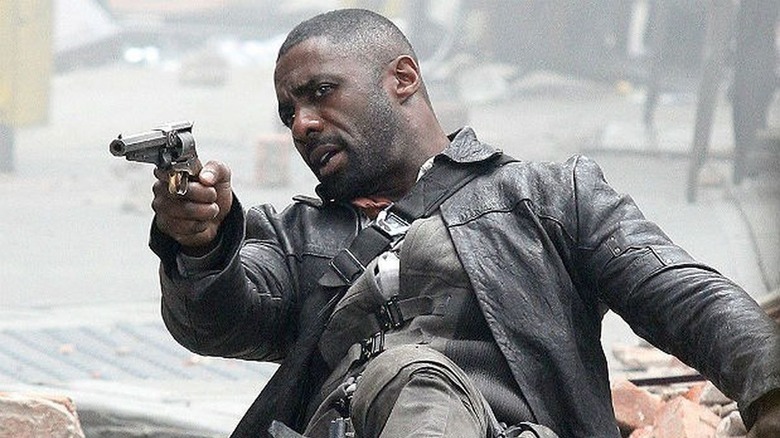Sci-Fi Movies You Never Realized Were In The Same Universe
You'd be forgiven if you feel overwhelmed by the plethora of shared universes. Did you see the first "Doctor Strange"? If you're interested in "Doctor Strange in the Multiverse of Madness," you'll need to watch two "Avengers" movies, "Spider-Man: No Way Home," and all of "WandaVision" to understand what's going on. The DC Universe is even more confusing. While there are some projects that take place within the same continuity, there are also standalone films like "The Batman" and "Joker" that aren't set in the primary universe. DC is adopting its version of the "multiverse" in the upcoming film "The Flash," which will feature the return of Michael Keaton's Batman from the Tim Burton films, as well as Ben Affleck's version from Zack Snyder's projects. That's going to confuse your average audience member who simply thought that Robert Pattinson was the new Batman.
If you love "Star Wars" and want to delve into the Expanded Universe, you may be surprised to find that some of the older "Star Wars" books are no longer part of the official "canon." Although Timothy Zahn's "Heir to the Empire" is no longer "canon," the character Thrawn has been reintroduced in the modern "Star Wars" franchise. That's all without mentioning franchises such as "Transformers," "Ghostbusters," "Sonic the Hedgehog," "Despicable Me," "Rocky," and "The Conjuring" that are also trying to start their own shared universes. Take a look at some of the other sci-fi movies that you never realized were in the same universe.
Star Wars and E.T. the Extra-Terrestrial
George Lucas and Steven Spielberg have been lifelong friends and close collaborators on several projects. Spielberg was convinced that "Star Wars" would be a colossal hit, even when Lucas had his own doubts about the film's success. Spielberg and Lucas agreed to share profits on "Star Wars" and "Close Encounters of the Third Kind," as they both believed in each other's success. It was Spielberg who was proven right when "Star Wars" became the highest-grossing film of all time. However, it was Spielberg who stole back the record a few years later when "E.T. the Extra-Terrestrial" bested "Star Wars" at the box office. "E.T." had a much different take on the science fiction genre compared to "Star Wars," but that didn't stop Lucas and Spielberg from adding in a few fun Easter Eggs that suggest that they take place within the same universe.
There's a scene in "E.T. the Extra-Terrestrial" where Elliot (Henry Thomas) takes his alien friend out to collect candy on Halloween. After seeing a child dressed as Yoda, E.T. says "home." A version of "Yoda's Theme" from "The Empire Strikes Back" plays in the background. Does this mean that E.T. has visited the "Star Wars" universe? Well, in "The Phantom Menace," a group of aliens that look like E.T. can be spotted in the Galactic Senate. Perhaps, E.T. had to return home so that he could complete his Jedi training with Master Yoda.
Star Wars and Indiana Jones
"E.T. the Extra-Terrestrial" isn't the only Spielberg film that contains references to the galaxy far, far away. Famously, Lucas and Spielberg took a vacation during the opening weekend of "Star Wars." As they relaxed on the beach, Spielberg told Lucas that he had always wanted to make a James Bond movie. Lucas thought that he had an even better idea, and pitched his friend on the "Indiana Jones" franchise. The two franchises are very similar, as "Star Wars" was inspired by classic science fiction serials like "Buck Rogers" and "Flash Gordon," while "Indiana Jones" was inspired by the adventure serials from the same era. Jones searches for relics from history, and "Star Wars" does take place "a long time ago." A few clever Easter Eggs suggest that perhaps the events of the "Star Wars" universe are ancient history in the "Indiana Jones" timeline.
When Indy searches through the Well of Souls in "Raiders of the Lost Ark," hieroglyphic images of R2-D2 and C-3PO can be spotted in the background. In "Indiana Jones and the Temple of Doom," Indy escapes from a bar named "Club Obi-Wan" in the film's opening sequence. A clever one-shot issue of the non-canon "Star Wars Tales" comic book series imagined Indy's search for more "Star Wars" objects. "Into the Great Unknown" shows Indy discovering the remnants of the "Millennium Falcon," which has crash-landed on Earth. Indy even remarks that things are "all somewhat familiar."
Back to the Future and A Million Ways to Die in the West
If you've ever watched an episode of "Family Guy" or "American Dad!," you know that Seth MacFarlane loves including surprising cameos from celebrities. He's brought the same sense of humor to his live-action film projects such as 2012's "Ted," which features an extended cameo from Sam J. Jones, who starred in the original "Flash Gordon" film from 1980.
MacFarlane's western comedy "A Million Ways to Die in the West" isn't nearly as funny as "Ted," but it does feature a pretty amazing cameo that almost single-handedly makes it worth recommending. During a late night, Albert Stark (MacFarlane) hears some strange noises coming from a shed. When he looks inside, he finds Doc Brown (Christopher Lloyd) working on a version of the DeLorean time machine. This is a fun nod to the "Back to the Future" series, as Doc is trapped in the Old West between the events of "Back to the Future Part II" and "Back to the Future Part III." Theoretically, "A Million Ways to Die in the West" doesn't contradict anything that happens in the "Back to the Future" trilogy. Although this is nothing more than a fun cameo, it's probably the closest thing to an actual "Back to the Future" sequel that we are ever going to get. Robert Zemeckis has assured fans that he will never make a "Back to the Future: Part IV," even if Lloyd has some interest in doing it.
District 9 and Elysium and Chappie
Neill Blomkamp is certainly one of the signature science fiction auteurs working today, even if his films have steadily declined in quality. "District 9" felt like a breath of fresh air compared to the current sci-fi landscape. The film's earnest depiction of xenophobia and apartheid felt politically relevant, and Blomkamp created some truly riveting character moments. While "Elysium" had no shortage of great action, its commentary on the health care disparity didn't feel quite as clever as Blomkamp may have imagined. That's more than you can say about "Chappie," as Blomkamp's heartwarming robot film felt like a tired retread of other movies about artificial intelligence.
Blomkamp's ambition has never been in doubt, and even when he fails it's nice to know that there are some filmmakers out there that are committed to working on original ideas. Before he made "District 9," Blomkamp proved his merit as a creator with the 2004 short film "Tetra Vaal", a name that might seem familiar if you've seen his other films. "Tetravaal" is the name of the weapons manufacturing company that designs the robots in "Chappie." You can also spot a "Teravaal" logo in the background in "District 9." Does this mean that the films are connected? In a Reddit AMA, Blomkamp denied that they take place in the same continuity, although he has referred to the films as a "trilogy" because of their stylistic similarities. However, he has been adamant that "District 10" is still in development.
Moon and Mute
Like Neill Blomkamp, Duncan Jones is a filmmaker whose commitment to original science fiction projects is very admirable. Jones' 2009 film "Moon" was the rare film that made time travel work, and featured one of the best performances that Sam Rockwell has ever given. Jones' follow-up, "Source Code," was just as compelling. He also definitely deserves credit for making a "Warcraft" film that wasn't entirely incoherent. That being said, any goodwill that Jones had with sci-fi fans may have disappeared after the release of his film "Mute," a science fiction neo-noir that feels like a complete retread of films like "Blade Runner," "Dark City," and "Minority Report." While there are some interesting visuals, the film's world-building was confusing and not very interesting. It felt like all of the creativity of "Moon" had disappeared. Although they seem like polar opposites, Jones has suggested that the two films take place in the same universe.
"Moon" follows astronaut Sam Bell's (Rockwell) isolation on the lunar surface, where he discovers several clones of himself. It's implied that one of Bell's clones returns to Earth to expose his corrupt employer, Lunar Industries. This trial briefly appears on a television screen in "Mute." Jones told Entertainment Weekly that the Easter Egg was included to satisfy "those people who cared about what happened at the end of 'Moon.'" He also indicated that a third film could tie the projects closer together. After "Mute," is that something we want to see?
Universal Monsters
Universal Pictures hilariously tried to create a new cinematic universe featuring iconic movie monsters called the "Dark Universe," which never made it past the first film. The 2017 wannabe blockbuster "The Mummy" was intended to be the "Iron Man" of the Dark Universe, but the film notoriously failed at the box office and received terrible reviews. Universal had planned to develop new versions of the Invisible Man, Van Helsing, Frankenstein's monster, The Phantom of the Opera, The Creature From The Black Lagoon, and The Wolfman, but these projects were set aside after "The Mummy" became such a disappointment. There's a new Dracula film called "Renfield" starring Nicolas Cage that will be released next year, but it doesn't have anything to do with the Dark Universe.
The Dark Universe is based on a concept that Universal Picture once perfected. Starting with 1931's "Dracula," Universal created several classic monsters films that were set within the same continuity, including "Frankenstein," "The Bride of Frankenstein," "The Invisible Man," "The Creature From The Black Lagoon," and "The Wolf Man." There were many crossover projects. Dracula and the Invisible Man popped up in "House of Frankenstein," and the three monsters encountered each other again in "House of Dracula." Universal even managed to bring the comedians Bud Abbott and Lou Costello into the universe. "Abbott and Costello Meet Frankenstein," "Abbott and Costello Meet the Invisible Man," and "Abbott and Costello Meet the Mummy" featured fun appearances from different monsters.
Ghostbusters and Casper
The original "Ghostbusters" is a fairly standalone science fiction comedy, but that hasn't stopped people from trying to turn it into a blockbuster franchise. "Ghostbusters II" was a disappointing sequel that failed to capture the same comedic charm, 2016's "Ghostbusters" felt like it was repeating the same story beats, and "Ghostbusters: Afterlife" tried too hard to inspire nostalgia. There are even more "Ghostbusters" films coming, with a "Ghostbusters: Afterlife" sequel set to be released in 2023 along with an animated spinoff project also in the works.
However, it doesn't sound like any of these new "Ghostbusters" films will be featuring an appearance by Casper the Friendly Ghost. Dan Aykroyd actually had a brief cameo as his "Ghostbusters" character Ray Stantz in the 1995 film "Casper," showing up to make fun of how incompetent the real Ghostbusters seem to be. Apparently, Ray was able to take a break from his job in New York City and head over to Maine so he could investigate the Ghostly Trio. "Ghostbusters: Afterlife" established that there are several units of Ghostbusters working in other offices in different locations. Does this mean that one of these units could run into Casper at some point? Unfortunately, it does not seem very likely that there are any other crossovers in the near future. DreamWorks Animation bought the rights to Casper before it was bought by NBCUniversal. The chances that Universal and Sony could cooperate on a new universe featuring both "Ghostbusters" and "Casper" seem slim.
Alien and Blade Runner and Soldier
Director Ridley Scott's influence on the science fiction genre speaks for itself, and while "Alien" and "Blade Runner" are two entirely different projects there are a few Easter Eggs suggesting they may take place in the same universe. A video screen that reads "PURGE" appears in both films. That may not be enough evidence to support a shared universe theory, but the 20th Anniversary Edition "Alien" DVD that was released in 1999 mentions that Captain Dallas (Tom Skerritt) had taken a job from the Tyrell Corporation, which is the company that develops replicants in "Blade Runner." Scott later says on the "Blade Runner" DVD commentary that the futuristic version of Los Angeles "could easily be the city that supports the crew that go out in 'Alien.'" While "Alien" takes place in the year 2122, the earliest events in "Prometheus" don't take place until around 2089, several generations after the future of "Blade Runner 2049." Is it possible that the androids in the "Alien" universe were based on the replicants from "Blade Runner"? David certainly goes through the same soul searching that Roy Batty was dealing with.
It should also be noted that Paul W.S. Anderson's 1998 movie "Soldier" was intended as an unofficial "side-quel" to "Blade Runner," having been penned by the same screenwriter (David Peoples) and featuring references to battles at the Tannhäuser Gate and the Shoulder of Orion, as well as a flying spinner car in a junkyard.
The Stephen King Universe
Stephen King is a very prolific writer, with 64 novels and over 200 short stories earning him the nickname "King of Horror." There have been many adaptations of King's work, and some are definitely better than others. It seems like for every classic like "The Shawshank Redemption," "The Shining," or "Stand by Me" you get a complete disaster like "The Dark Tower," "Cell," or "The Lawnmower Man." King has left several Easter Eggs in his stories that suggest that they all take place in the same connected universe. The "Man in Black" from "The Dark Tower" has appeared in "The Stand," "Salem's Lot," and "Children of the Corn," while the character Dick Hallorann from "The Shining" used his magic to save Mike Hanlon's father before "It." Magic operates in similar ways throughout King's stories, and the concept of "Ka" from "The Dark Tower" is a running theme.
Does this mean that all of the movies based on King's work take place within one giant multiverse? At this point, it seems unlikely. Regardless of the fact that these adaptations have been released by many different studios, the central text within King's "multiverse" is "The Dark Tower." Unfortunately, the 2017 adaptation of "The Dark Tower" was a colossal failure, and the Amazon series doesn't appear to be moving forward. However, any fans that still want to entertain the theory can track Stephen King's many cameo appearances in adaptations of his work.
